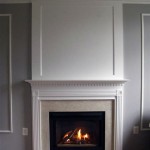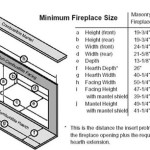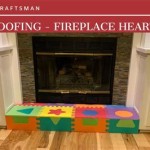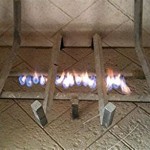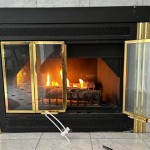Enhancing Fireplace Aesthetics and Safety: A Comprehensive Guide to Trim Around the Fireplace Floor
Fireplaces are often focal points in homes, offering warmth and visual appeal. However, the area surrounding the fireplace floor, commonly referred to as the hearth or firebox landing, often requires careful consideration in terms of aesthetics and functionality. Properly installed and maintained trim around the fireplace floor not only enhances the beauty of the fireplace but also contributes to fire safety and the overall durability of the surrounding flooring. This article explores the various aspects of fireplace floor trim, covering types of materials, installation techniques, and safety considerations.
Material Selection: Balancing Aesthetics, Durability, and Fire Resistance
The choice of material for trim around the fireplace floor is paramount, as it directly impacts the overall appearance, longevity, and safety of the installation. Several materials are commonly used, each offering unique characteristics. Common materials include:
Stone (Granite, Marble, Slate): Stone is a popular choice due to its inherent fire resistance, durability, and aesthetic appeal. Granite is known for its hardness and resistance to scratching and staining, making it suitable for high-traffic areas. Marble offers a more elegant look, with intricate veining and a smooth finish. Slate provides a rustic, natural appearance with excellent heat resistance. Stone trims are typically more expensive than other options, but their longevity and visual impact often justify the investment.
Tile (Ceramic, Porcelain): Tile offers a wide range of design possibilities, with various colors, patterns, and sizes available. Ceramic tile is a cost-effective option for decorative purposes, although it may not be as durable as other materials. Porcelain tile is denser and more resistant to water absorption, making it a better choice for areas prone to moisture exposure. Both ceramic and porcelain tiles are non-combustible, providing adequate fire protection.
Brick: Brick is a traditional material that complements the classic look of many fireplaces. It is highly fire-resistant and provides excellent thermal mass, helping to retain heat. Brick trim can be laid in various patterns, adding texture and visual interest to the fireplace surround.
Metal (Steel, Cast Iron): Metal trim offers a modern and industrial aesthetic. Steel and cast iron are both highly durable and fire-resistant materials. Metal trim can be custom-fabricated to fit specific fireplace designs and can be powder-coated or painted to achieve different finishes.
Wood: While wood can be used for trim, it requires careful consideration due to its combustibility. When using wood, it should be fire-retardant treated and installed at a safe distance from the firebox opening. Wood trim is often used in combination with other non-combustible materials, such as tile or stone, to create a decorative border. The National Fire Protection Association (NFPA) provides specific guidelines for the use of combustible materials near fireplaces, which must be adhered to for safety.
When selecting a material, it is crucial to consider the overall style of the room, the existing flooring, and the level of fire protection required. Consulting with a professional contractor or designer can help determine the best material for a specific fireplace and budget.
Installation Techniques: Ensuring a Secure and Safe Trim
Proper installation is crucial for the longevity and safety of the trim around the fireplace floor. The installation process typically involves several steps:
Preparation: The first step involves preparing the subfloor or existing floor surface. This may require cleaning, leveling, and repairing any cracks or damage. The subfloor should be solid and stable to provide a secure base for the trim.
Measuring and Cutting: Accurate measurements are essential for a precise fit. The trim should be cut to the appropriate dimensions using a saw or tile cutter, depending on the material. Mitered corners are often used to create a seamless transition between the trim pieces.
Adhesive Application: An appropriate adhesive, such as thin-set mortar for tile or stone, or construction adhesive for wood, should be applied to the subfloor. The adhesive should be spread evenly to ensure proper bonding between the trim and the subfloor.
Trim Placement: The trim pieces should be carefully placed onto the adhesive, ensuring that they are level and aligned correctly. Spacers can be used to maintain consistent spacing between the trim pieces. For stone or tile, a rubber mallet can be used to gently tap the trim into place.
Grouting (for Tile and Stone): Once the adhesive has cured, grout should be applied to fill the gaps between the tile or stone pieces. The grout should be carefully worked into the joints using a grout float. Excess grout should be removed with a damp sponge.
Sealing (Optional): Some materials, such as natural stone, may benefit from sealing to protect them from staining and moisture damage. A sealant should be applied according to the manufacturer's instructions.
Finishing: The final step involves cleaning the trim and surrounding area to remove any residual adhesive or grout. Any necessary touch-ups or repairs should be made at this time.
For complex installations or when working with heavy materials like stone, it is recommended to hire a professional installer to ensure that the trim is installed correctly and safely. A professional installer will have the necessary tools and expertise to handle the project efficiently and effectively.
Safety Considerations: Protecting Against Fire Hazards
Fire safety is a paramount concern when installing and maintaining trim around the fireplace floor. Several safety measures should be taken to minimize the risk of fire hazards:
Clearance from the Firebox Opening: Maintaining adequate clearance between combustible materials and the firebox opening is crucial. The NFPA provides specific guidelines for clearance distances, which vary depending on the type of fireplace and the combustible material. Generally, wood trim should be kept at least 6 inches away from the firebox opening on the sides and top. Non-combustible materials, such as stone and tile, can be installed closer to the opening.
Fire-Retardant Treatment: If wood trim is used, it should be treated with a fire-retardant coating to reduce its flammability. Fire-retardant coatings can help to slow down the spread of fire, providing valuable time to escape in the event of a fire.
Hearth Extension: The hearth extension, which is the non-combustible area in front of and to the sides of the firebox opening, should be sized according to the manufacturer's specifications or local building codes. The hearth extension is designed to protect the floor from sparks and embers that may escape from the firebox.
Regular Inspections: The fireplace and surrounding area should be inspected regularly for any signs of damage or deterioration. Cracks in the firebox, damaged trim, or loose mortar should be repaired promptly to prevent fire hazards. A professional chimney sweep should inspect the chimney annually to ensure that it is clean and free of obstructions.
Smoke Detectors and Carbon Monoxide Detectors: Functional smoke detectors and carbon monoxide detectors should be installed in the vicinity of the fireplace to provide early warning of a fire or carbon monoxide buildup. These detectors should be tested regularly to ensure that they are working properly.
Fire Extinguisher: A fire extinguisher should be readily accessible near the fireplace in case of a small fire. A Class ABC fire extinguisher is suitable for extinguishing most types of fires that may occur in a residential setting.
By adhering to these safety guidelines, homeowners can significantly reduce the risk of fire hazards associated with fireplaces and ensure the safety of their homes and families.
In addition to the above considerations, the selection of materials, installation techniques, and safety measures must comply with local building codes and regulations. These codes provide minimum standards for fire safety and construction practices, ensuring that fireplaces are installed and maintained in a safe and responsible manner. Consulting with local building officials or a qualified contractor can help homeowners navigate the complexities of building codes and ensure compliance with all applicable regulations.
Furthermore, regular maintenance of the fireplace and its surrounding area is essential for maintaining its safety and aesthetic appeal. This includes cleaning the firebox regularly, removing any debris that may accumulate in the chimney, and inspecting the trim for any signs of damage or deterioration. Prompt repairs and maintenance can help to prevent minor issues from escalating into more serious problems, saving homeowners time and money in the long run.
Ultimately, the trim around the fireplace floor plays a crucial role in enhancing the beauty, safety, and functionality of the fireplace. By carefully considering the material selection, installation techniques, and safety considerations, homeowners can create a fireplace that is not only visually appealing but also provides a safe and comfortable environment for their homes and families.

A New Transition In The Living Room Home Moyaone

Edging For Flooring Around Fireplace Mumsnet

Help Edging Trim For Fireplace Heart Hometalk

Trim Detail Around Fireplace Floor Flooring Molding

Elegant Hardwood Moldings For Fireplace Hearths

Seal Around The Fireplace Hearth

How To Trim Vinyl Flooring Around Fireplace Hearth Hometalk

Brick Fireplace Makeover You Won T Believe The After Harper House

Diy Fireplace Finished Addicted 2 Decorating

Transition Moldings Unique Wood Floors Fireplace Hearth Installing Hardwood Burner

